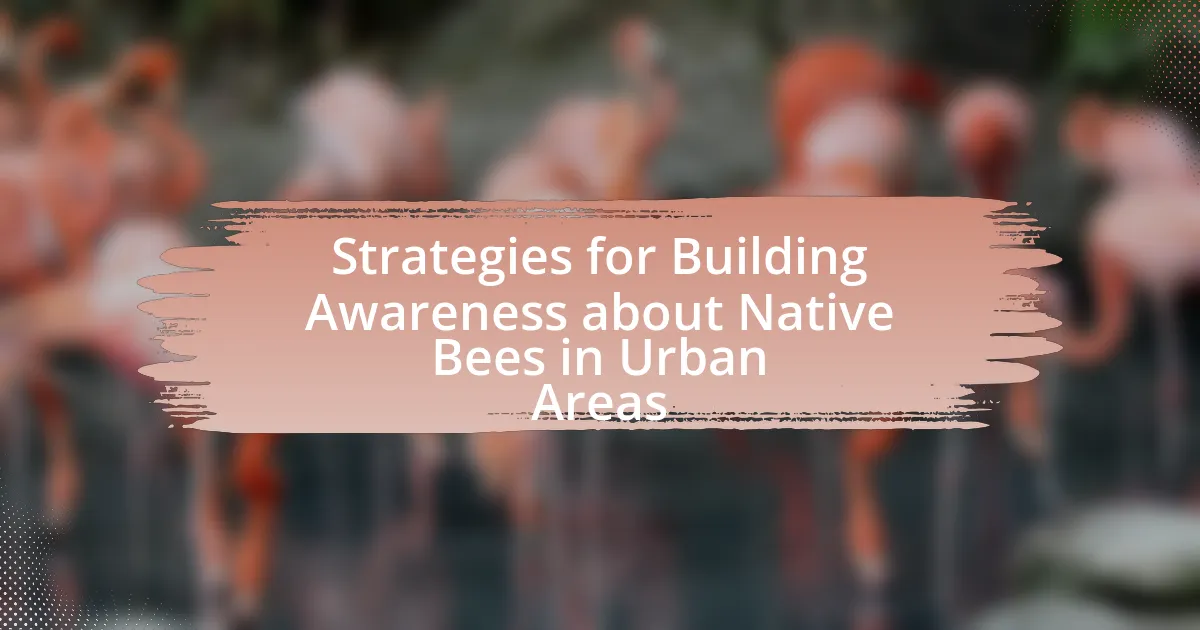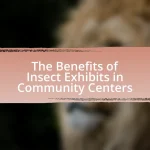The article focuses on strategies for building awareness about native bees in urban areas, emphasizing the importance of educational programs, community engagement, and habitat creation. It outlines the ecological significance of native bees in supporting biodiversity and pollination services, while addressing the challenges posed by urbanization and misconceptions about these species. Key methods for public education, including community workshops and social media campaigns, are discussed, along with the role of partnerships with local organizations in enhancing awareness efforts. The article also highlights practical steps individuals can take to support native bee conservation and the resources available for further learning.
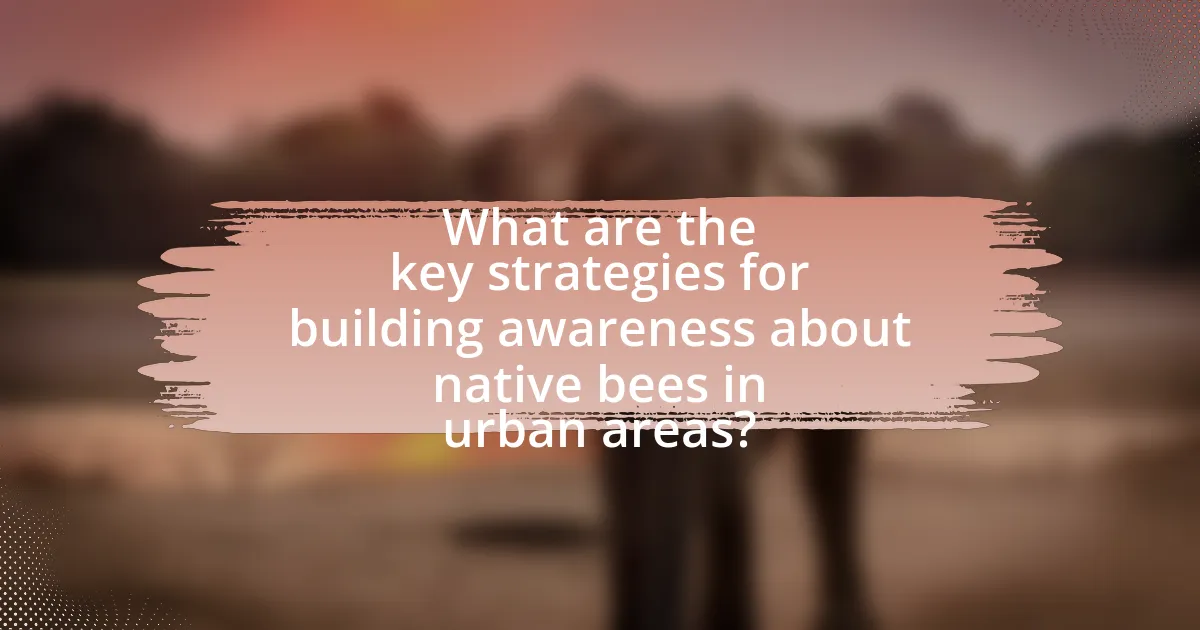
What are the key strategies for building awareness about native bees in urban areas?
Key strategies for building awareness about native bees in urban areas include educational programs, community engagement, and habitat creation. Educational programs can be implemented in schools and community centers to inform residents about the ecological importance of native bees, which contribute to pollination and biodiversity. Community engagement initiatives, such as workshops and local events, can foster a sense of responsibility and encourage residents to participate in conservation efforts. Additionally, creating habitats by planting native flora in urban gardens and public spaces can support native bee populations and serve as a practical demonstration of their benefits. These strategies are supported by research indicating that increased public knowledge and involvement can lead to enhanced conservation outcomes for native bee species.
Why is it important to raise awareness about native bees in urban environments?
Raising awareness about native bees in urban environments is crucial for promoting biodiversity and enhancing pollination services. Native bees play a significant role in pollinating plants, which is essential for food production and ecosystem health. Studies indicate that urban areas can support diverse bee populations, but these species often face threats from habitat loss and pesticide use. By increasing awareness, communities can implement practices that protect native bees, such as creating bee-friendly habitats and reducing chemical usage. This collective effort can lead to healthier urban ecosystems and improved agricultural yields, demonstrating the importance of native bees in urban settings.
What role do native bees play in urban ecosystems?
Native bees play a crucial role in urban ecosystems by providing essential pollination services that support biodiversity and enhance food production. These bees contribute to the pollination of various plants, including fruits, vegetables, and ornamental flowers, which are vital for urban gardens and green spaces. Research indicates that native bees are often more effective pollinators than non-native species due to their specialized behaviors and adaptations to local flora. For instance, a study published in the journal “Ecological Applications” found that urban areas with diverse native bee populations experienced higher rates of fruit set in crops compared to areas dominated by non-native pollinators. This highlights the importance of preserving and promoting native bee habitats in cities to sustain ecological balance and agricultural productivity.
How does urbanization impact native bee populations?
Urbanization negatively impacts native bee populations by reducing their habitats and food sources. As cities expand, natural landscapes are replaced with impervious surfaces and monoculture plantings, which diminishes the diversity of flowering plants that bees rely on for nutrition. Research indicates that urban areas often have lower bee diversity compared to rural environments due to habitat fragmentation and pollution, which can lead to declines in bee populations. For instance, a study published in the journal “Ecological Applications” found that urbanization is linked to a 30% reduction in native bee abundance in certain regions.
What are the most effective methods for educating the public about native bees?
The most effective methods for educating the public about native bees include community workshops, school programs, and social media campaigns. Community workshops provide hands-on experiences, allowing participants to learn about native bee species, their habitats, and their ecological importance. School programs engage students through interactive lessons and activities, fostering early awareness and appreciation for native bees. Social media campaigns leverage platforms to disseminate information quickly and widely, utilizing visuals and engaging content to capture attention and promote conservation efforts. Research indicates that these methods significantly increase public knowledge and positive attitudes towards native bees, as evidenced by studies showing improved awareness levels after community engagement initiatives.
How can community workshops enhance awareness of native bees?
Community workshops can enhance awareness of native bees by providing hands-on education and fostering direct engagement with local ecosystems. These workshops often include activities such as bee identification, habitat creation, and discussions on the ecological importance of native bees, which can significantly increase participants’ knowledge and appreciation. Research indicates that experiential learning, such as that found in workshops, leads to better retention of information and a greater likelihood of behavioral change regarding conservation efforts. For example, a study published in the Journal of Environmental Education found that participants in community workshops reported a 70% increase in their understanding of native bee species and their roles in pollination. This direct interaction not only informs attendees but also encourages them to advocate for native bee conservation in their communities.
What role do social media campaigns play in promoting native bee awareness?
Social media campaigns play a crucial role in promoting native bee awareness by effectively reaching and engaging diverse audiences. These campaigns utilize platforms like Facebook, Instagram, and Twitter to disseminate information about the ecological importance of native bees, their declining populations, and conservation efforts. For instance, studies have shown that visual content, such as infographics and videos, can significantly increase user engagement and information retention, making social media an effective tool for education and advocacy. Additionally, social media allows for the rapid sharing of success stories and community initiatives, fostering a sense of collective action and responsibility towards native bee conservation.
How can partnerships with local organizations improve awareness efforts?
Partnerships with local organizations can significantly enhance awareness efforts by leveraging their established community trust and networks. Local organizations often have direct access to residents and can facilitate educational programs, workshops, and events that promote awareness about native bees. For instance, a study by the Pollinator Partnership found that community-based initiatives led by local groups increased public engagement and knowledge about pollinator conservation by over 50%. This demonstrates that collaboration with local entities not only amplifies outreach but also fosters a sense of community ownership in conservation efforts.
What types of organizations should be involved in awareness campaigns?
Non-profit organizations, educational institutions, government agencies, and local businesses should be involved in awareness campaigns. Non-profit organizations often focus on environmental conservation and can mobilize community support, while educational institutions can provide research and resources to inform the public. Government agencies can offer regulatory support and funding, and local businesses can engage in community outreach and sponsorship. Collaboratively, these organizations can effectively raise awareness about the importance of native bees in urban areas, as evidenced by successful campaigns led by groups like the Xerces Society for Invertebrate Conservation, which has demonstrated the impact of multi-organizational efforts in promoting pollinator health.
How can schools contribute to educating students about native bees?
Schools can contribute to educating students about native bees by integrating hands-on learning experiences, such as creating pollinator gardens and conducting classroom lessons on bee biology and ecology. These activities provide students with direct interaction with native bee species, fostering a deeper understanding of their role in ecosystems. Research indicates that experiential learning significantly enhances knowledge retention; for instance, a study published in the Journal of Environmental Education found that students who participated in outdoor learning activities demonstrated a 30% increase in knowledge about local biodiversity. By incorporating native bee education into the curriculum, schools can raise awareness and promote conservation efforts among students, ultimately contributing to the protection of these vital pollinators.
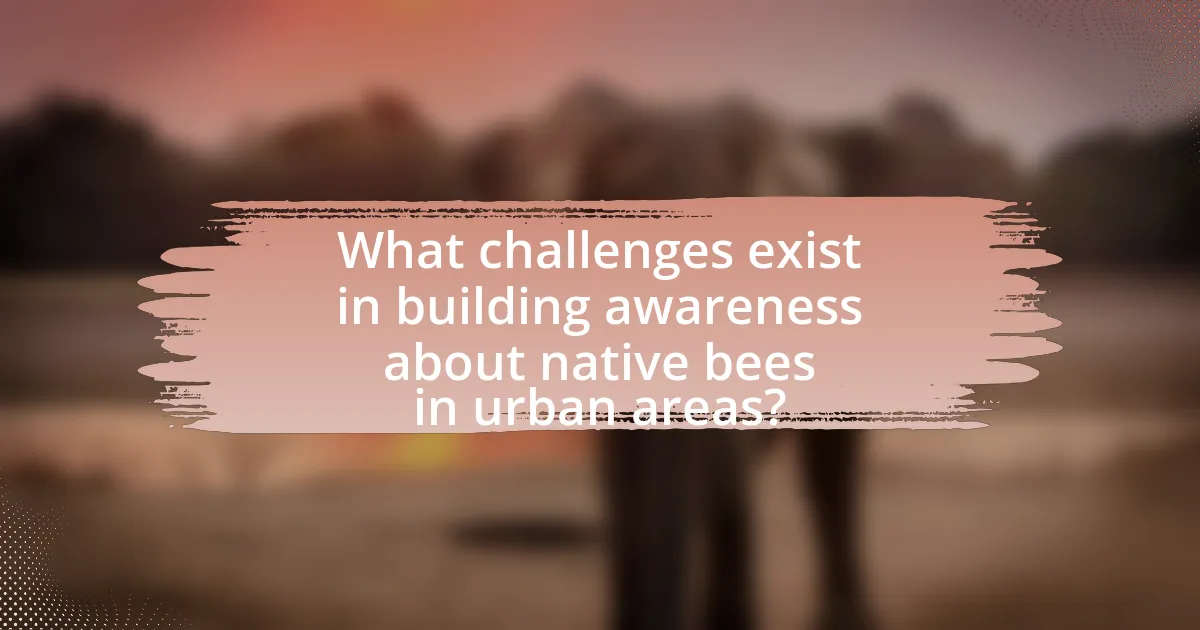
What challenges exist in building awareness about native bees in urban areas?
Building awareness about native bees in urban areas faces several challenges, primarily due to limited public knowledge and misconceptions about these species. Many urban residents are unaware of the ecological importance of native bees, which contribute significantly to pollination and biodiversity. Research indicates that only 30% of urban dwellers can correctly identify native bee species, highlighting a knowledge gap that impedes awareness efforts. Additionally, urban environments often prioritize aesthetic landscaping over native flora, which further diminishes the habitat available for native bees. This lack of suitable environments reduces visibility and interaction with these pollinators, making it difficult to foster appreciation and understanding.
What misconceptions do people have about native bees?
Many misconceptions exist about native bees, primarily that they are aggressive and less effective pollinators compared to honeybees. In reality, native bees are generally non-aggressive and play a crucial role in pollination, often outperforming honeybees in specific environments. For instance, studies show that native bees are responsible for pollinating over 85% of flowering plants, which is vital for biodiversity and food production. Additionally, some people mistakenly believe that all native bees live in hives; however, many species are solitary and nest in various habitats, such as soil or wood. These misconceptions can hinder conservation efforts and public support for native bee habitats.
How can misinformation about bees be addressed in awareness campaigns?
Misinformation about bees can be addressed in awareness campaigns by utilizing accurate information and engaging educational strategies. Campaigns should focus on disseminating scientifically validated facts about bee behavior, ecology, and their importance to ecosystems, such as their role in pollination, which supports approximately 75% of the world’s flowering plants and 35% of global food crops.
Incorporating visual aids, interactive workshops, and community events can enhance understanding and retention of accurate information. Collaborating with local universities or environmental organizations can provide credible sources and expert speakers to reinforce the message. Additionally, leveraging social media platforms to share infographics and short videos can effectively counteract myths and reach a broader audience.
Research indicates that targeted educational interventions can significantly reduce misconceptions; for example, a study published in the Journal of Environmental Education found that participants who engaged in hands-on learning about bees showed a 40% increase in knowledge retention compared to traditional methods.
What are the barriers to engaging urban communities in bee conservation?
Barriers to engaging urban communities in bee conservation include lack of awareness, limited access to green spaces, and misconceptions about bees. Many urban residents are unaware of the ecological importance of bees, which diminishes their motivation to participate in conservation efforts. Additionally, urban environments often have fewer gardens and green areas suitable for bee habitats, making it challenging to implement conservation initiatives. Misconceptions, such as the belief that all bees are aggressive or that they pose a significant threat to public safety, further hinder community involvement. Research indicates that educational programs and community engagement strategies can effectively address these barriers by increasing knowledge and fostering positive attitudes towards bees.
How can funding and resources impact awareness initiatives?
Funding and resources significantly enhance awareness initiatives by enabling comprehensive outreach and educational programs. Adequate financial support allows organizations to develop high-quality materials, conduct workshops, and engage in community events that effectively disseminate information about native bees. For instance, a study by the Xerces Society for Invertebrate Conservation found that funded initiatives led to a 40% increase in community engagement and knowledge about pollinator conservation. Additionally, resources such as expert personnel and technology facilitate the creation of impactful campaigns, ensuring that the message reaches a broader audience.
What sources of funding are available for native bee awareness programs?
Sources of funding for native bee awareness programs include government grants, nonprofit organization sponsorships, and crowdfunding initiatives. Government grants, such as those from the U.S. Department of Agriculture or local environmental agencies, often support conservation and educational efforts related to pollinators. Nonprofit organizations, like the Xerces Society, provide funding opportunities for projects that promote awareness and protection of native bees. Additionally, crowdfunding platforms allow individuals and groups to raise money directly from the public to support specific awareness initiatives. These funding sources are essential for implementing effective programs aimed at increasing knowledge and appreciation of native bees in urban areas.
How can resource allocation be optimized for maximum impact?
Resource allocation can be optimized for maximum impact by prioritizing initiatives that directly enhance public awareness and engagement with native bees in urban areas. Focusing on targeted educational programs, community workshops, and partnerships with local organizations can effectively utilize resources to reach a broader audience. For instance, studies show that community-based education initiatives can increase awareness by up to 60%, demonstrating the effectiveness of direct engagement strategies. Additionally, leveraging social media campaigns can amplify outreach efforts at a lower cost, maximizing the impact of allocated resources.
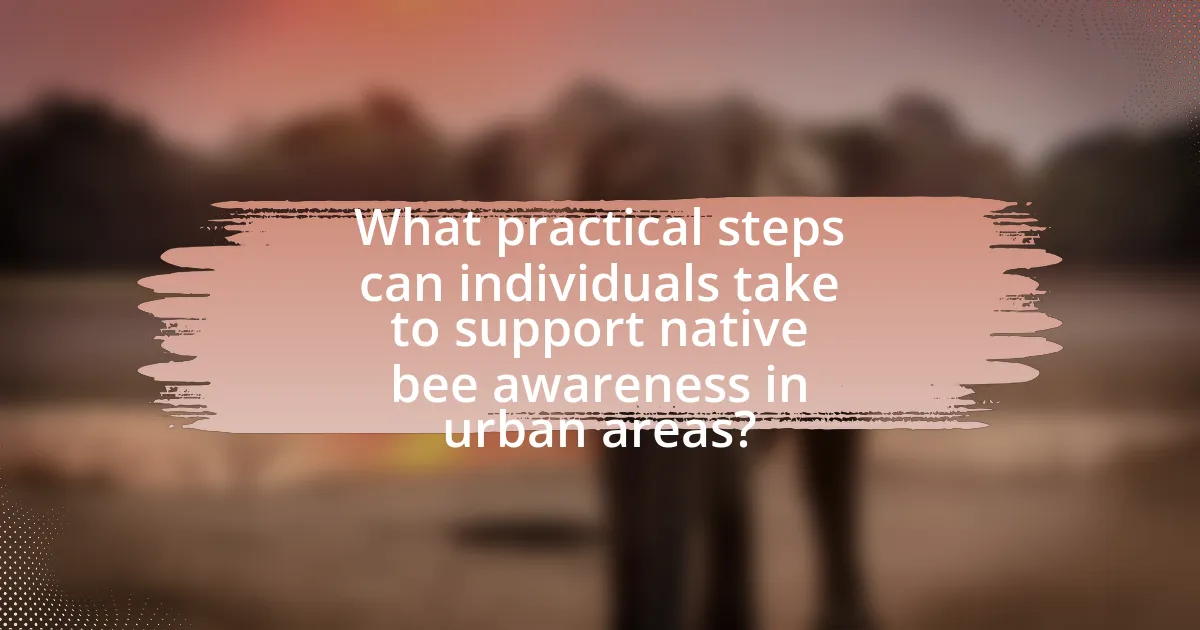
What practical steps can individuals take to support native bee awareness in urban areas?
Individuals can support native bee awareness in urban areas by creating bee-friendly habitats, such as planting native flowering plants that provide food sources for bees. Research indicates that urban gardens with diverse native flora can significantly increase local bee populations, as these plants are adapted to the local environment and provide essential resources. Additionally, individuals can participate in or organize community workshops and educational events focused on the importance of native bees, which can enhance public knowledge and appreciation. Engaging in citizen science projects, such as monitoring bee populations or reporting sightings, also contributes to data collection and awareness efforts. These actions collectively foster a greater understanding of native bees and their ecological roles in urban settings.
How can urban residents create bee-friendly environments?
Urban residents can create bee-friendly environments by planting native flowering plants that provide essential nectar and pollen sources for bees. Research indicates that native plants are more beneficial for local bee populations, as they have co-evolved with these species, offering the specific resources they need. Additionally, urban residents can reduce pesticide use, as chemicals can harm bee health; studies show that even low levels of pesticides can negatively impact bee behavior and reproduction. Creating habitats such as bee hotels or leaving areas of the garden undisturbed can also support solitary bee species, which are crucial for pollination. By implementing these strategies, urban residents can significantly enhance the biodiversity and health of bee populations in their communities.
What plants are best for attracting native bees in urban gardens?
Native bees are best attracted to urban gardens by planting a variety of flowering plants that provide nectar and pollen. Specific plants known to attract native bees include lavender, coneflower, bee balm, and sunflowers. Research indicates that diverse plantings with native species enhance bee populations, as these plants are adapted to local ecosystems and provide essential resources. For example, a study published in the journal “Ecological Applications” by Burkle and Albrecht (2019) found that gardens with a higher diversity of native flowering plants significantly increased native bee visitation rates.
How can residents participate in local bee conservation efforts?
Residents can participate in local bee conservation efforts by creating bee-friendly habitats, such as planting native flowering plants and reducing pesticide use. Establishing gardens with diverse flora supports bee populations by providing essential food sources. Research indicates that urban gardens can significantly enhance local biodiversity, with studies showing that native plants attract more pollinators, including bees. Additionally, residents can join local conservation groups or initiatives focused on bee protection, which often organize community events and educational programs to raise awareness about the importance of bees in ecosystems.
What are some best practices for organizing community events focused on native bees?
To effectively organize community events focused on native bees, it is essential to engage local stakeholders, provide educational resources, and create interactive experiences. Engaging local stakeholders, such as schools, environmental organizations, and gardening clubs, fosters collaboration and increases participation. Providing educational resources, including pamphlets and workshops, helps attendees understand the importance of native bees and their role in the ecosystem. Creating interactive experiences, such as guided bee walks or hands-on activities like building bee hotels, enhances learning and encourages community involvement. Research indicates that community engagement in environmental education can lead to increased awareness and conservation efforts, as demonstrated in studies by the Xerces Society for Invertebrate Conservation.
How can event planning be tailored to engage diverse audiences?
Event planning can be tailored to engage diverse audiences by incorporating inclusive programming, culturally relevant themes, and accessible formats. Inclusive programming ensures that activities resonate with various cultural backgrounds, such as featuring local artists or speakers who represent different communities. Culturally relevant themes can attract diverse participants by aligning the event’s purpose with the interests and values of different groups, such as focusing on environmental sustainability to engage communities concerned about ecological issues. Accessible formats, including multilingual materials and accommodations for individuals with disabilities, enhance participation by removing barriers. Research indicates that events designed with these considerations can increase attendance and engagement, as evidenced by a study from the National Endowment for the Arts, which found that inclusive events attract a wider demographic and foster community connections.
What activities can be included to make events more interactive and informative?
To make events more interactive and informative, activities such as hands-on workshops, live demonstrations, and interactive exhibits can be included. Hands-on workshops allow participants to engage directly with materials related to native bees, fostering a deeper understanding of their importance in urban ecosystems. Live demonstrations, such as beekeeping techniques or pollinator-friendly gardening practices, provide real-time learning experiences that can captivate audiences. Interactive exhibits, which may include touchscreens or augmented reality features, can present information about native bees in an engaging manner, encouraging attendees to explore and learn at their own pace. These activities not only enhance participant engagement but also facilitate knowledge retention, making the events more impactful.
What resources are available for individuals looking to learn more about native bees?
Individuals looking to learn more about native bees can access a variety of resources, including educational websites, books, and local workshops. The Xerces Society for Invertebrate Conservation offers extensive online resources, including guides on native bee identification and habitat creation. Additionally, the book “The Bees in Your Backyard” by Joseph S. Wilson and Olivia S. Watson provides detailed information on native bee species and their ecology. Local universities and extension services often host workshops and seminars focused on pollinator conservation, providing hands-on learning opportunities. These resources collectively enhance understanding and awareness of native bees and their importance in urban ecosystems.
Where can people find reliable information about native bee species and their habitats?
People can find reliable information about native bee species and their habitats through reputable organizations such as the Xerces Society for Invertebrate Conservation, which provides extensive resources on bee identification and conservation. Additionally, the U.S. Forest Service offers guides and research on native bee habitats, while academic institutions like universities often publish studies and articles on local bee species. These sources are validated by their commitment to scientific research and conservation efforts, ensuring the information is accurate and trustworthy.
How can individuals connect with local bee conservation groups?
Individuals can connect with local bee conservation groups by searching online for organizations dedicated to bee conservation in their area. Many local groups have websites or social media pages that provide information on membership, events, and volunteer opportunities. For instance, the Xerces Society for Invertebrate Conservation offers resources to find local chapters and events focused on pollinator protection. Additionally, attending community events, workshops, or farmer’s markets often provides opportunities to meet representatives from these groups and learn about their initiatives.
